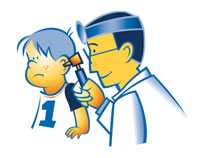One Page Sheet: Fluid in Middle Ear Q&As
Guide for Parents
Print-friendly color version [1 page]
Print-friendly black & white version [1 page]
Español: PREGUNTAS Y RESPUESTAS— Líquido en el oído medio
Questions and Answers: Fluid in the Middle Ear (Otitis Media with Effusion)

A healthcare provider said your child has fluid in the middle ear, also called otitis (oh-TIE-Tus) media with effusion (uh-FEW-zhun) (OME). Fluid usually does not bother children, and it almost always goes away on its own. This does not have to be treated with antibiotics, unless it lasts for a few months. Here are some facts about OME and ear infections.

Q: What are the main kinds of ear infections?
A: The main kinds of ear infections are:
- Swimmers’s ear (otitis externa) is an infection of the ear canal that can be painful and is treated with eardrops.
- A middle ear infection, which a healthcare provider might call "acute otitis media" (AOM), may cause ear pain, fever, or an inflamed eardrum, and is often treated with oral antibiotics.
Q: What causes OME?
A: Fluid may build up in the middle ear for two reasons. When a child has a cold, the middle ear makes fluid just as the nose does – it just doesn’t run out as easily from the middle ear. After a middle ear infection, fluid may take a month or longer to go away.
Q: Are antibiotics ever needed for OME?
A: Sometimes antibiotics may be needed if the fluid is still present after a few months and is causing decreased hearing in both ears. For this reason, your child will need an ear check in a few months. If there is still fluid in the middle ear, your child may need a hearing test.
Q: What should I do?
A: If there is fluid in the middle ear:
- The best treatment is to wait and watch your child. Since fluid in the middle ear rarely bothers children, it is best to let it go away on its own. Right now, your child does not need antibiotics.
- You may need to schedule a visit to see the healthcare provider again in the few months to be sure the fluid is gone.
Q: Why not try antibiotics now?
A: Taking antibiotics when they are not needed can be harmful. Each time people take antibiotics, they are more likely to carry resistant germs in their noses and throats. These resistant germs cannot be killed by common antibiotics. Your child may need more costly antibiotics, antibiotics given by a needle, or may even need to be in the hospital to get antibiotics. Since OME will almost always get better on its own, it is better to wait and take antibiotics only when they are needed.
1-800-CDC-INFO
www.cdc.gov/getsmart/community
U.S. Department of Health and Human Services
Centers for Disease Control and Prevention
- Page last reviewed: April 17, 2015
- Page last updated: April 17, 2015
- Content source:


 ShareCompartir
ShareCompartir